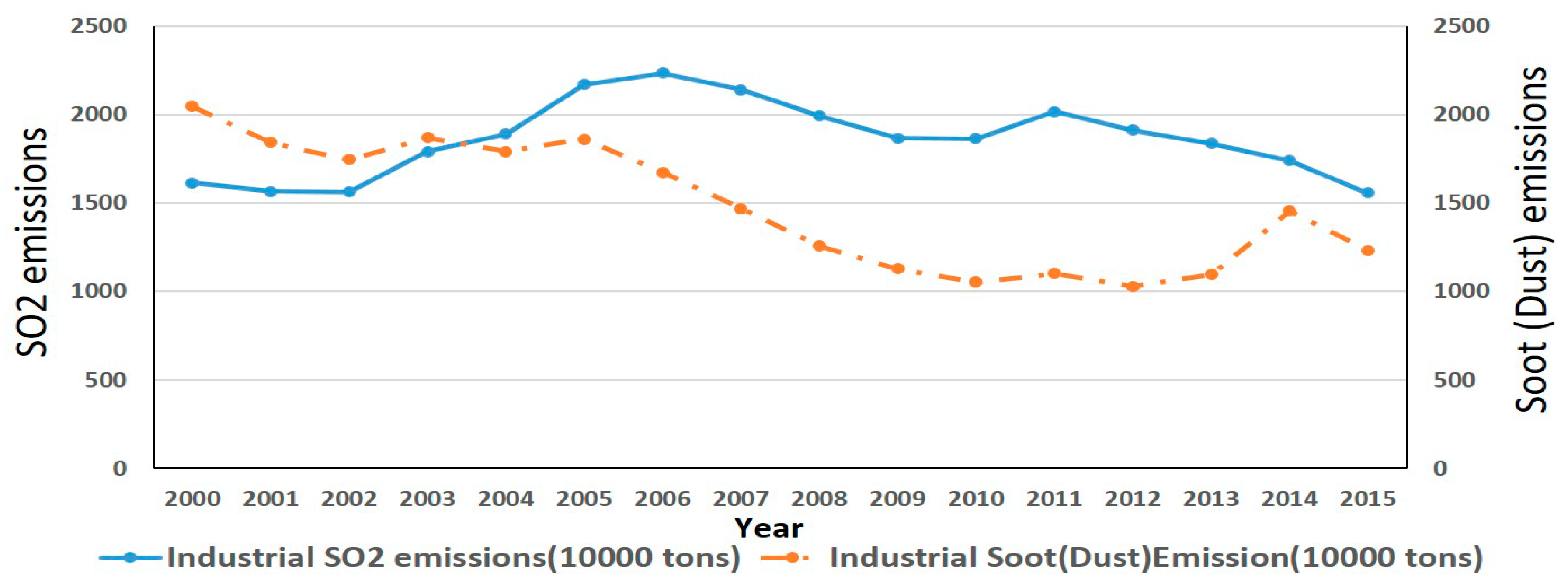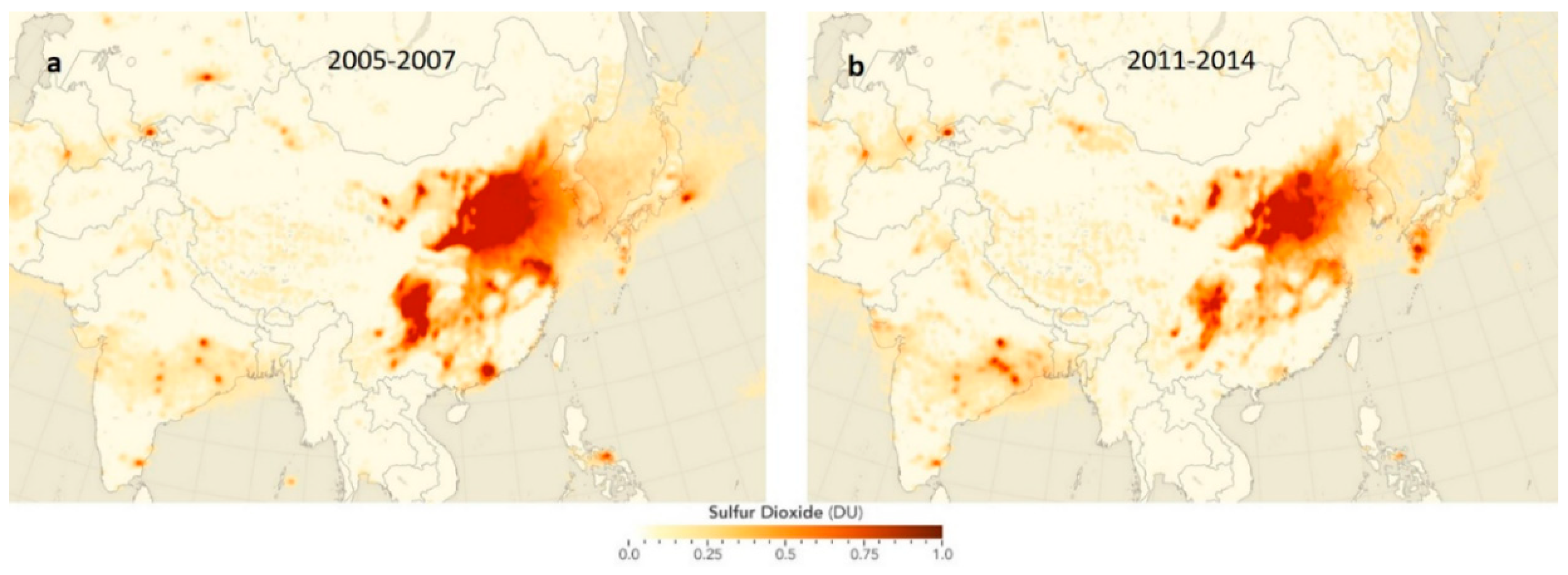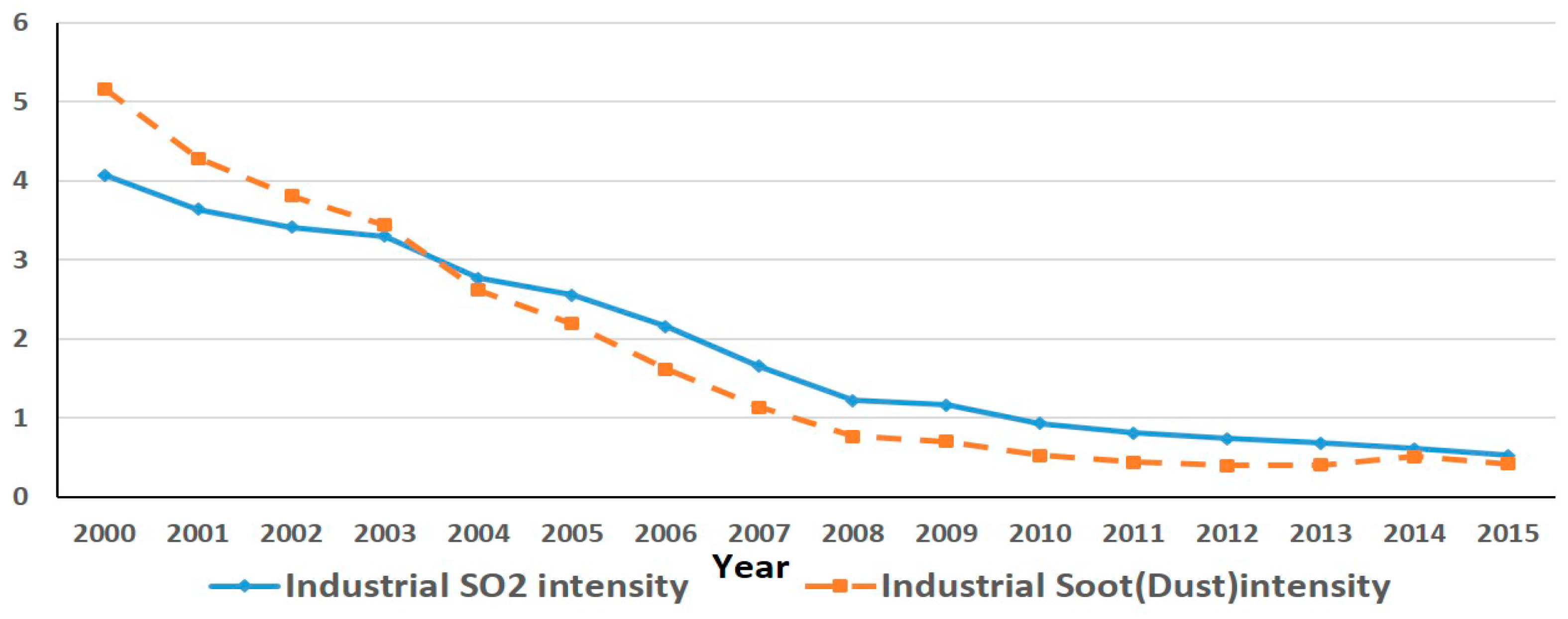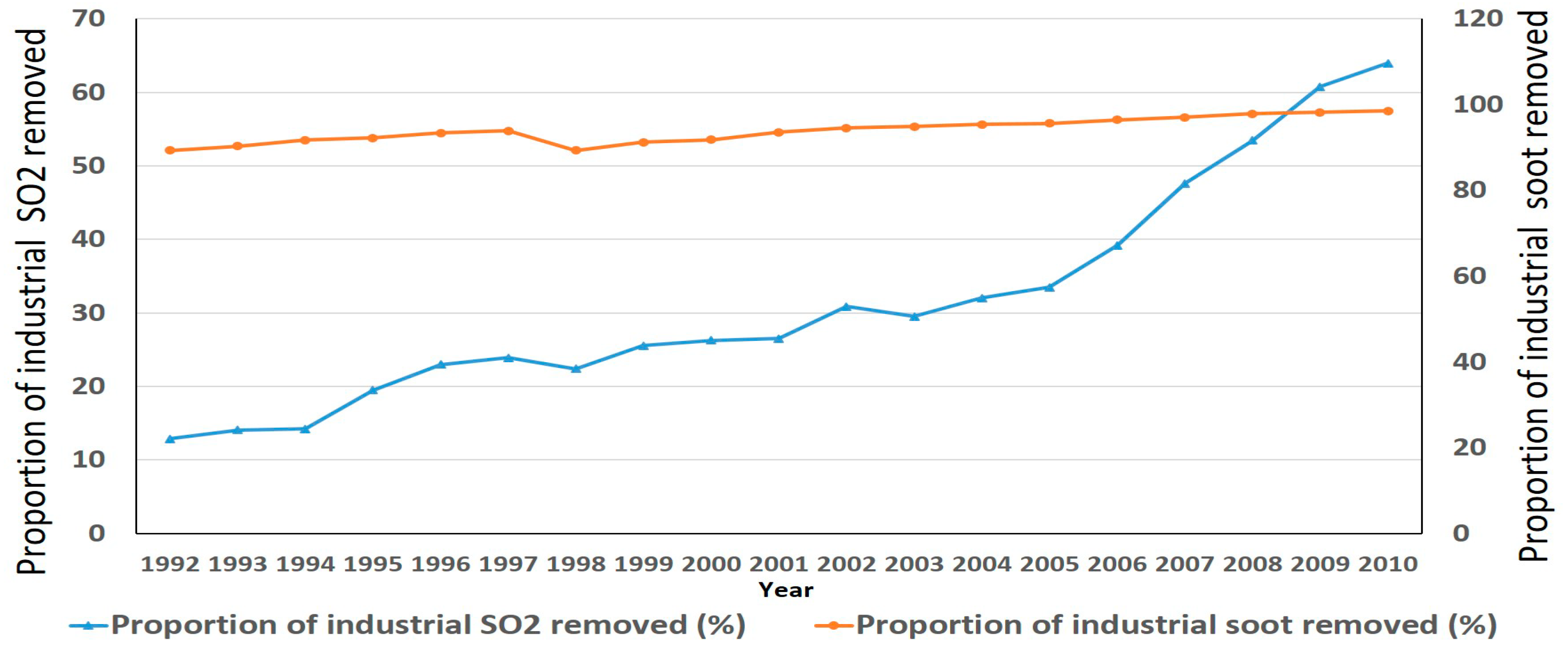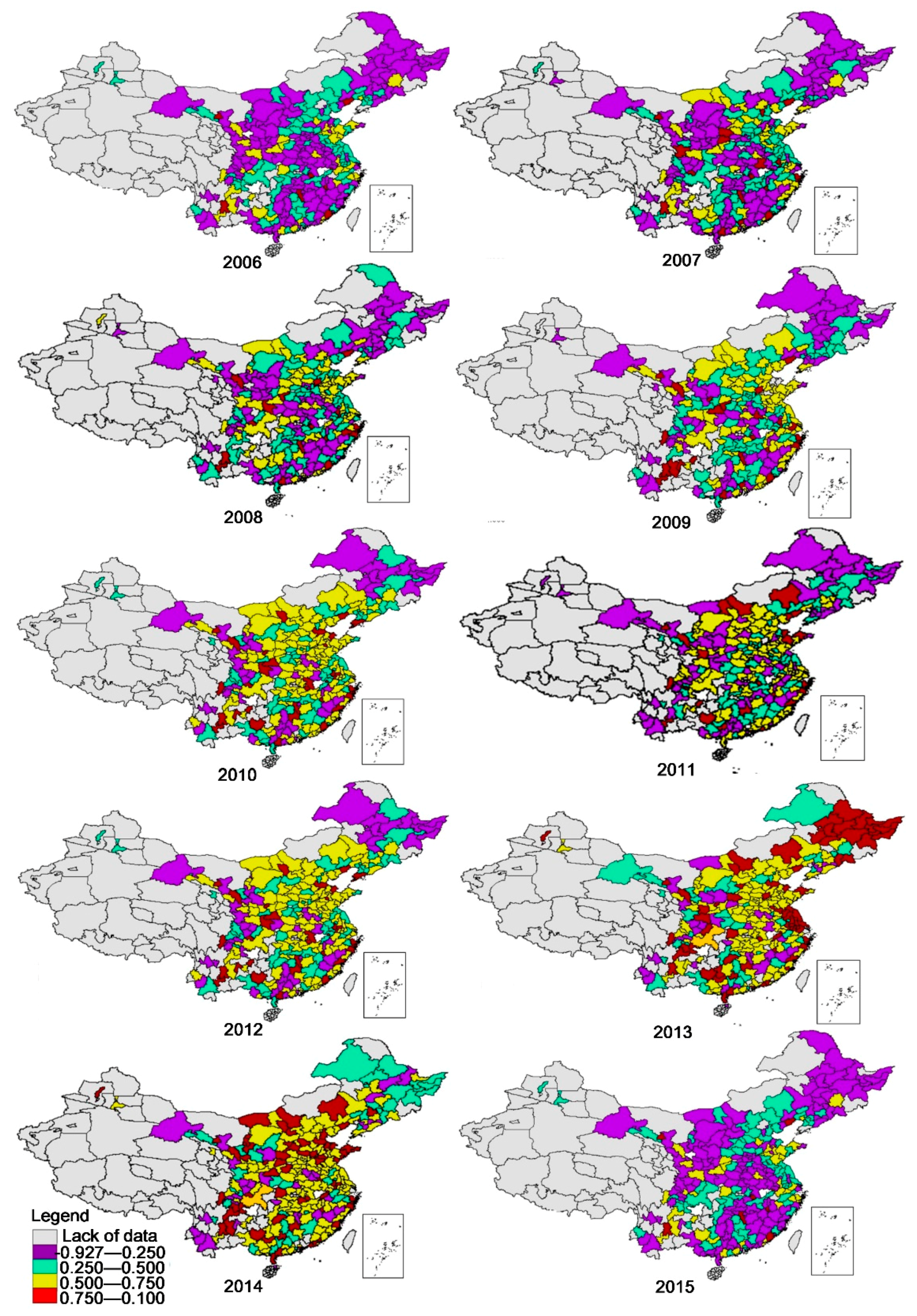3.1. Background of Environmental Regulations in China
Over the past decades, the environmental quality in China has increasingly deteriorated. Based on the monitoring data of groundwater quality from 6124 monitoring sites in 235 prefecture-level and above cities in China, only 10.1% of the cities obtain a grade of good [
33]. In Yale University’s 2016 Environmental Performance Index (EPI), China is one of the worst performers (ranked 109 out of 180 countries) with respect to its water quality [
34]. The
Environmental Analysis Report of China jointly issued by the Asian Development Bank and Tsinghua University on 14 January 2013 shows that seven of the world’s ten most polluted cities are in China. The percentage of the 500 big cities in China that meets the air quality standards of the World Health Organization (WHO) is less than 1%. However, the Chinese government has been actively controlling air pollution with fiscal and administrative means. The increasingly polluted environment has affected our quality of life. It has led to high economic and societal costs and it constitutes an obstacle to the long-term sustainable development of the economy.
As early as the beginning of 1980’s, environmental protection had already been classified as the fundamental state policy [
35]. After the introduction of the
Law of Environmental Protection of China in 1989, the National People’s Congress and its standing committee have instigated 29 laws about environmental and resources protection, including the
Prevention and Cure Law on Water Pollution, the
Atmospheric Pollution Prevention Law, the
Environmental Pollution Prevention and Control Law of Solid Wastes, and others [
36]. Environmental regulations have accompanied environmental pollution over the past decades.
Emissions of industrial dust (soot) and SO
2 actually started to decline after 2005 (see
Figure 1), although their absolute values are still high. Actually, the Chinese government had tried to reduce SO
2 emissions since 2007 in preparation for the 2008 Beijing Olympics. In Aug 2012, targeted energy conservation and emission reductions were proposed as part of the Chinese government’s 12th Five-year Plan (2011–2015). The
Air Pollution Prevention and Control Action Plan issued by the State Council in 2013 aimed at reducing air pollution with specific targets. For example, by 2017, the urban concentration of inhalable particles should decrease by 10% compared with 2012 levels. The coexistence of rapid national economic growth and improved environmental conditions shows that Chinese environmental regulations and improved energy efficiency have played certain roles in this process.
Foreign observational data also confirms declining SO
2 emissions in China (see
Figure 2). The reduction of SO
2 is significant (about a 60% reduction from 2012 to 2015), although SO
2 levels in China remain the highest in the world [
37,
38]. This change shows that Chinese environmental regulation policies aiming at improving air quality have functioned well.
Apart from the decrease in absolute value, the change in relative level also indicates a similar trend in environmental regulations. This study combines pollution emissions with economic indexes to illustrate the pollution situation (see
Figure 3), it’s clear that both intensities have been falling during the period, which further confirms the previous statements.
To examine specific changes in the intensity of environmental regulations, we plot the intensity over time for each pollutant (see
Figure 4). The figure reveals that environmental regulations have been more stringent since 1990s. Then, what is the price for achieving this? Is the impact of environmental regulations on employment positive or negative in China?
3.2. The U-Shaped Relationship between Environmental Regulations and Employment
In the context of increasing intensity of environmental regulations, the economic growth pattern cannot adapt to it in the short term due to the development inertia, which eventually leads to a drop in the employment absorption capacity. According to the statistical data of China’s Ministry of Human Resources and Social Security in 2016, 13.14 million new jobs in urban areas were created. This is an increase of approximately 0.15 percent year-on-year, and the fourth straight year of remaining over 13 million. At the same time, there were approximately 15 million new unemployed youth who all need jobs, which indicates that the employment gap is large, especially considering those who cannot find a job over the years. In fact, urban registered unemployment in China hit 9 million in 2010. The unemployment rate has held at approximately 4 percent since then. Since Chinese unemployment registration system is deficient, a large gap exists between the registration and the actual condition.
In addition to the quantity contradiction, structural contradiction also affects the job market, which often manifests as more new jobs are created without enough qualified employees accompanied by the upgrade of the industrial structure. Therefore, it is necessary to account for the influence on the job market exerted by the government’s environmental regulations when formulating the policies. We cannot achieved this without a detailed understanding of the complex linkages between environmental regulations and the job market.
Previous researches have addressed the connection between environmental regulations and economy-wide employment. Since worker-level analyses are rare, this paper evaluates the effects of the regulations on worker-level employment. This theoretical model builds on the works of Cahuc (2004) [
32] and Cole (2008) [
23], in which pollution emissions were regarded as one production factor, and its price can be represented by environmental regulations. When environmental regulations become more stringent, the pollution costs of enterprises will be higher. This signal leads to a series of adjustments in production modes and employment. Based on this assumption, we build the partial equilibrium production model. This model supposes that: First, an enterprise has
N kinds of production factors, including labor inputs, pollution inputs, and other inputs (like capital, technology etc. all represented by “other” for simplicity). Second, the intensity of regulations equals the pollution costs. Third, polluting enterprises will be regulated by the government through levying taxes, on carbon emissions or other polluting activities according to discharge standards. These punishments will directly increase the pollution costs. In other words, enterprises will choose the optimal combination of production factors in a given level of output that is determined by profit maximization. For simplicity, take a Cobb–Douglas production function to describe the enterprise’s production activities.
where
denotes the output of the polluting enterprise,
W denotes the pollution input,
denotes the labor input, and
T represents all other inputs.
α,
β, and
γ are the pollution-elasticity, labor-elasticity and other factors’ elasticity, respectively (
). Enterprises select the level of
W to maximize profit
r:
where
P denotes the price of products made by enterprises,
represents the price of labor,
Q denotes the price of other input factors, and
C is the price of
W. With the increasing intensity of environmental regulations, pollution costs will be higher, which increases
C. There is a positive relationship between
C and the intensity of environmental regulations. After the partial derivative of function
MAX(
r) with respect to the variable
W,
and
T, we can get Equation (3) according to profit maximization.
Our measurement of the relationship between regulatory stringency and employment growth is based on the assumption that when environmental regulations are tightened, each enterprise faces a proportional rise in costs and will reduce its initial labor employment. It can be shown that:
where
represents the price elasticity of pollution inputs. Since
C is already defined, it refers to the intensity of environmental regulations.
denotes the price elasticity of pollution inputs. When regulations are tightened, enterprises will reduce expenditures on pollution. Therefore,
. We add a minus sign in Equation (4) to make sure that
is non-negative. Equation (4) can be decomposed into two parts. First,
represents the employment change caused by the change in the relative price between
and
, and we can call it the substitution effect. Second,
represents the employment change caused by the change of enterprises’ production scales under the regulations, and we call this change the scale effect. These two effects have opposite signs.
The effect of on C is determined by . When 1, then and the scale effect is bigger than the substitution effect. , which implies that the effect of on C is negative. When , then . , and the effect is positive. Considering the economic meaning of , at the initial stage of environmental regulations, enterprises have to expand its pollution prevention investments to meet the regulatory standards. However, the quantity of this investment gradually diminishes, and the proportional decrease will be bigger than the increase in regulatory stringency. Therefore, . As regulations become more stringent, enterprises do not need to invest as much as the initial stage in pollution prevention. Since the room for decreasing pollution prevention investments is limited, the increasing degree of regulatory stringency will be bigger. Therefore, . The effect of a stringent environmental regulation policy can be summarized as follows. As environmental pollution intensity increases, will change from 1 to 1 and will be replaced by . In other words, the employment growth that accompanies the increase in environmental controls will be better after the deterioration in the initial stage.
After the analyses above, it could be found that there exists two effects of regulations on employment: the scale effect and the substitution effect. Increasing regulatory stringency will simultaneously create both, but the substitution effect is initially smaller than the scale effect, then bigger with the increase of investment in pollution prevention. That is to say, environmental regulations will increase an individual’s employment probability when the regulatory stringency reaches a given level. Therefore, there exists a “U” type relationship between environmental regulations and an individual’s employment probability.
Is the reality of China consistent with this? If the “U” relationship is true, are there any differences of the position of different regions of China in this U-shaped curve? Does industrial heterogeneity of the effect of regulations on an individual’s employment probability exist? These questions will be discussed in the empirical part of this paper.
3.3. Data Collection
The data about individual employment comes from the Chinese Household Income Project (CHIP) database [
39]. This database covers income and expenditure information in 1988, 1995, 2002, 2007, 2008, and 2013. These are called CHIP1988, CHIP1995, CHIP2002, CHIP2007, CHIP2008, and CHIP2013, respectively. The CHIP survey consists of three parts: the Urban Household Survey, the Rural Household Survey, and the Migrant Household Survey. Considering that the survey did not cover rural-to-urban migrants before 2002 and the information absence, this paper chooses CHIP2007, CHIP2008, and CHIP2013 data as the data sources. The 2007 and 2008 surveys are also a part of the larger RUMiC (Rural-Urban Migrants in China) survey project. Both contain 5000 households in the migration sample, 8000 households in the rural sample, and 5000 households in the urban sample. The data comes from interviews with questionnaires designed by the project team.
For the surveys of urban local households and rural-urban migrant households, nine provinces were selected as the survey target in 2007 and 2008. They were Shanghai, Jiangsu, Zhejiang, and Guangdong from eastern China; Anhui, Henan, and Hubei from central China, and Chongqing and Sichuan from western China. The rural household survey also covered nine provinces. Differing from the urban and migrant’s surveys, Shanghai was excluded, while Hebei was included. The CHIP 2013 sample was selected by the systematic sampling method in the east, center and west. It contains 14 provinces. They are Beijing, Liaoning, Jiangsu, Shandong, and Guangdong from eastern China, Shanxi, Anhui, Henan, Hubei, Hunan, and Chongqing from central China, and Sichuan, Yunnan, and Gansu from western China. This provided a total of 126 cities, 234 counties, 18,948 households, and 64,777 individuals. In this, there are 7175 urban households, 11,013 rural households, and 760 migrant households. As CHIP focuses on the employment situation and the income and expenditure information, it has been widely accepted by scholars aiming at researching Chinese employment and income problems, like Bishop and Liu, 2008 [
40]; Chen and Feng, 2011 [
41]; Bishop et al., 2014 [
42]; Gao et al., 2015 [
43] and Li et al., 2017 [
44]. That is also the primary reason that we choose CHIP as the input instead of others. Besides, CHIP also covers a survey of rural-to-urban migrants that makes it have the advantage of comparing different subsamples in the same topic then contributing to forming a comprehensive understanding of it. Other macro level data come from the
China City Statistical Yearbook and the
China Statistical Yearbook.
3.4. Econometric Model
An individual’s employment probability is defined as:
where
i denotes an individual,
j denotes a city,
t denotes the year, and
(the dependent variable) is a dummy variable that denotes employment status (employed = 1, unemployed = 0). Those “not in the labor force” are eliminated from the sample data, which exclude retirees, students, homemakers, women who are pregnant or in maternity leave, and people on long-term sick leave. The age ranges are from 16 to 60 for men and 16 to 55 for women.
represents the intensity of environmental regulations. Various methods can be used to measure it, including the emission density of different contaminants [
45], the pollutant emissions volume per unit of output [
46], a comprehensive index composed of multiple pollution indicators [
47,
48], a proxy index like per capita GDP [
21,
49] or cases of administrative penalty related to environmental protection [
28,
50]. The second method actually measures the pollution intensity without excluding the effect of technological and industrial factors. The third one is significantly affected by the weight of different indexes. Since per capita GDP, as an environmental regulation index, will be better among different countries than different regions of a country, the last one still has a lack of consensus. Xu and Song (2010) found that regions with higher average incomes does not necessarily have higher levels of environmental regulations [
51]. Therefore, this study chooses the first method and adopts the emission density of sulfur dioxide (SO
2) in each city as the measurement index. Most studies establish a provincial index that measures the level of environmental regulations. Considering the imbalances in regional development, economic levels vary a lot within a province, the index used in this paper established at the city level will be more accurate and convincing.
The data about industrial SO
2 emissions come from the
China City Statistical Yearbook [
52],
is the quadratic term of the regulatory intensity.
is an unobservable variable that is irrelevant to time.
denotes the time dummy, and
is the error term. In Equation (6),
represents the other factors that will affect
, including two categories: individual demographic characteristic and macro-level data. First, gender is represented by
(man = 1, woman = 0). Age is represented by
and its quadratic term
(unit is %). Nationality is represented by
(Han = 0, Minority = 1).
denotes the marital status (single = 0, not single = 1).
denotes years of formal education (excluding the number of years skipped or failed). Finally,
denotes one’s health condition (good = 1, not good = 0).
Next is the macro-level data. Fixed asset investments are denoted by
, which is measured as the ratio between total investments in fixed assets in urban areas and GDP of each city. Fixed asset investments are one of the most important forces for economic growth and fostering job creation in China. The variable
denotes government expenditure and is measured by the ratio between municipal expenditures and GDP. Due to the strong control of Chinese government over the economy, government expenditures are the main tool to achieve this, which then affects employment. Previous literatures have proven that, in the long run, an increase in public investment contributes to employment remarkably [
53].
The variable
denotes labor productivity measured by the ratio between annual gross output of all industrial enterprises above a designated size deflated by the GDP deflator (2000 as the base year) and the annual average number of workers in each city. Productivity growth has a positive impact on corporate profits but a significant negative effect on the labor demand per unit product. Therefore, labor productivity growth has a significant negative effect on employment growth [
54].
The variable denotes the developmental level of the regional economy measured by the real GDP (2000 as the base year) of each city. A higher economic development level often means more jobs created.
The variable
denotes the industrial structure measured by the share of second industrial output value to GDP. Different industries have different effects on employment [
55]. A higher share of the second industry often means more jobs.
The variable represents openness measured by the ratio between total actual FDI and the GDP of different cities. In an open economy, international investments will simultaneously create absorption and crowd-out effects. On one hand, foreign-capital enterprises will bring investments that will create more employment opportunities. On the other hand, it will diminish domestic investment and stimulate improved production efficiency, which have a negative effect on domestic employment. and are used to measure regional infrastructure and urban population density. represents the per capita area of paved roads in city. Since, enterprises are more likely to invest in a city with a higher infrastructure level, thereby more jobs will be created in these cities.
All macro-level data come from the
China City Statistical Yearbook [
52] and the
China Statistical Yearbook [
56]. To avoid the nonnormality and heteroscedasticity of variances, data of this level are logarithmically transformed.
In order to discuss the effects of regional and industrial heterogeneity, cities involved are divided into eastern, central, and western regions according to the standard released by the National Bureau of Statistics (NBS) of China in 2003. The industry classification standard comes from CHIP2013 that includes 20 Industries. The specific classification information and the matches between Chinese industries and US two-digit industries can be found in
Table S1. The data sources and the meaning of indexes can be found in
Table 1.
Table 1 shows that most observations have a job, and their education is over junior middle school. Openness varies greatly across the sample, the smallest one is 0.25, 0.19, and 0.12 percent of the size of the largest ones in 2007, 2008, and 2013, respectively. Most individuals are married and of the Han nationality. We also find that China’s economic level varies across regions. The highest city’s real GDP is approximately 83.76, 78.73, and 75.77 times bigger than the lowest one in 2007, 2008, and 2013, respectively.
